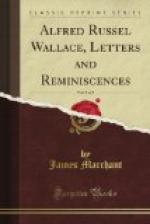When out of doors he usually carried an umbrella, and in the garden a stick, upon which he leaned rather heavily in his later years. His hair became white rather early in life, but it remained thick and fine to the last, a fact which he attributed to always wearing soft hats. He had full beard and whiskers, which were also white. His eyes were blue and his complexion rather pale. He habitually wore spectacles, and to us he never looked quite natural without them. Towards the end of his life his eyes were subject to inflammation, and the glasses were blue. His hands, though large, were not clumsy, and were capable of very delicate manipulation, as is shown by his skill in handling and preserving insects and bird-skins, and also in sketching, where delicacy of touch was essential. His handwriting is another example of this; it remained clear and even to the end, in spite of the fact that he wrote all his books, articles, and letters with his own hand until the last few years, when he occasionally had assistance with his correspondence; but his last two books, “Social Environment” and “The Revolt of Democracy,” written when he was 90 years of age, were penned by himself, and the MSS. are perfectly legible and regular.
He was very domestic, and loved his home. His interest extended to the culinary art, and he was fond of telling us how certain things should be cooked. This became quite a joke among us. He was very independent, and it never seemed to occur to him to ask to have anything done for him if he could do it himself—and he could do many things, such as sewing on buttons and tapes and packing up parcels, with great neatness. When unpacking parcels he never cut the string if it could be untied, and he would fold it up before removing the paper, which in its turn was also neatly folded.
His clothes were always loose and easy-fitting, and generally of some quiet-coloured cloth or tweed. Out of doors he wore a soft black felt hat rather taller than the clerical pattern, and a black overcoat unless the weather was very warm. He wore no ornaments of any kind, and even the silver watch-chain was worn so as to be invisible. He wore low collars with turned-down points and a narrow black tie, which was, however, concealed by his beard. He was not very particular about his personal appearance, except that he always kept his hair and beard well brushed and trimmed.
[Illustration: MRS. A.R. WALLACE (about 1895)]
In our early days at Grays we children were allowed to run in and out of his study; but if he was busy writing at the moment we would look at a book until he could give us his attention. His brother in California sent him a live specimen of the lizard called the “horned toad,” and this creature was kept in the study, where it was allowed to roam about, its favourite place being on the hearth.
About this time he read “Alice through the Looking-glass,” which pleased him greatly; he was never tired of quoting from it and using some of Lewis Carroll’s quaint words till it became one of our classics.




